University Policy Development: Chronic Disorders and Healthcare
VerifiedAdded on 2023/01/17
|9
|2338
|96
Report
AI Summary
This report analyzes the policy development surrounding chronic disorders in the United States, focusing on the affected population, evidence-based issues, and proposed solutions. The report identifies chronic disorders as a significant public health concern, particularly affecting the older population (65+), and highlights the impact on healthcare costs and quality of life. It provides a problem statement emphasizing the need for preventative measures and effective management strategies. Suggestions include healthcare professional involvement, educational initiatives in schools, community outreach, and media campaigns to promote healthy behaviors. The report outlines steps for policy change, including stakeholder collaboration and government support, and discusses the positive impacts on healthcare delivery, such as increased preventive care, reduced healthcare expenditure, improved patient satisfaction, and enhanced work-life balance for healthcare professionals. The report emphasizes the importance of lifestyle modifications and healthcare behavior changes to mitigate the effects of chronic disorders, supported by references to peer-reviewed studies and government resources.
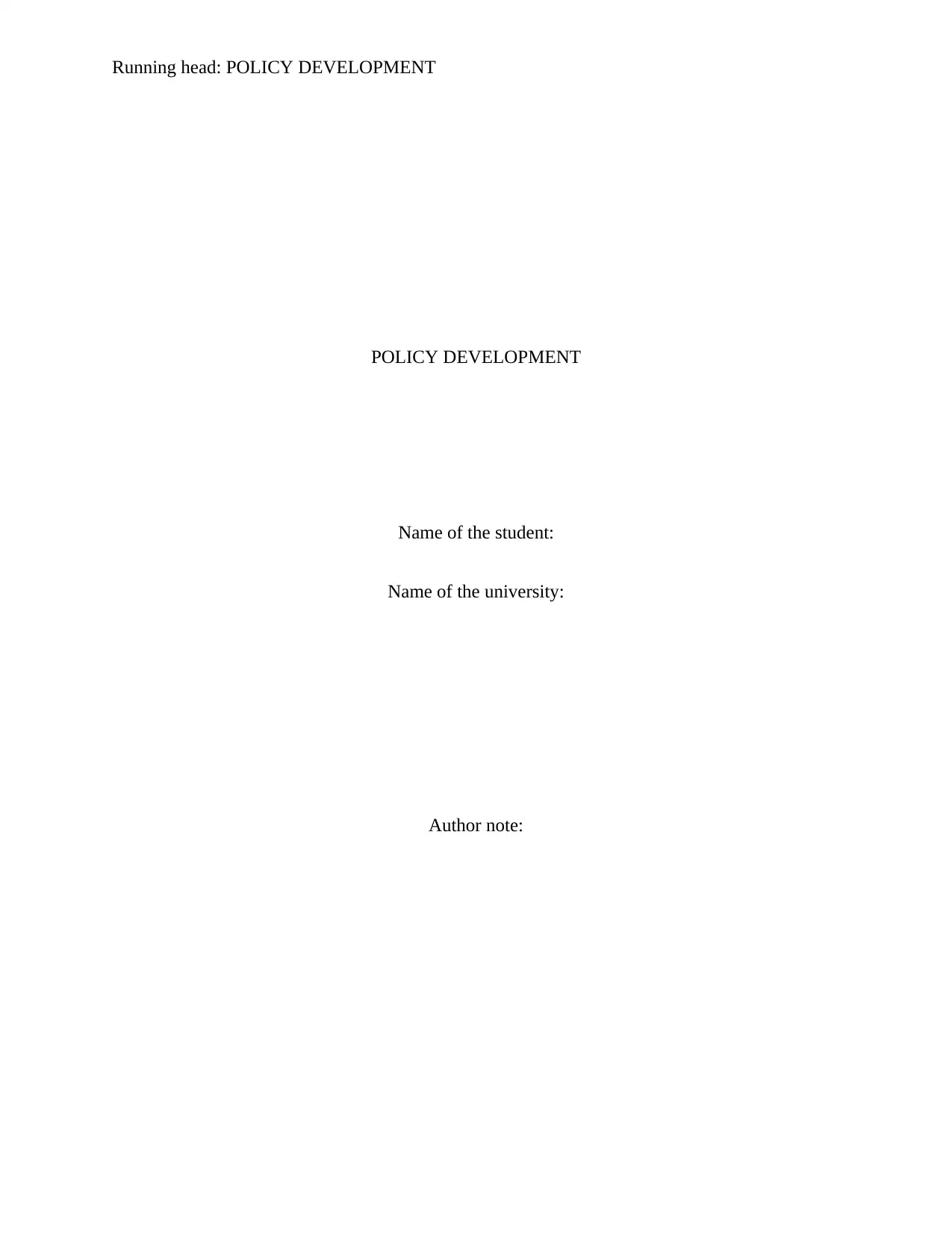
Running head: POLICY DEVELOPMENT
POLICY DEVELOPMENT
Name of the student:
Name of the university:
Author note:
POLICY DEVELOPMENT
Name of the student:
Name of the university:
Author note:
Paraphrase This Document
Need a fresh take? Get an instant paraphrase of this document with our AI Paraphraser

1
POLICY DEVELOPMENT
Policy health issue: Chronic disorders
Population who is affected:
Chronic disorders are those disorders that persist for a long time. According, to the
definition of the U.S. National Center for Health Statistics, a chronic disorder can be defined as
that particular disorder that lasts for 3 months or more. These disorders cannot be prevented by
vaccines or cannot be cured by medications. They can be only managed by proper lifestyle
modifications and to some extent by medications (Steptoe et al., 2015). Health damaging
behaviors like that of the tobacco use as well as lack of physical activity and poor eating habits
are some of the major contributors of leading chronic disorders.
Life expectancy of people in United States has increased over the last decade. It has
increased from the age of 70 years in the year 1960 to that of the age of 78.9 years in the year
2018. The modern day advancements in the fields of medicine as well as technological
innovations and scientific interventions in healthcare industry have helped people to live longer
lives (Scott et al., 2016). Although human beings are living longer in the nation but they are not
able to live quality lives. A huge number of people are seen to be suffering from chronic ailments
and are not able to manage the disorders successfully. One in four people in the nation has
multiple chronic conditions that require medical attention and have limited activities of daily
living. This number rises to three among four people who are aged 65 and older as per CDC
report. Hence, target population is the older cohort who is 65 and above (CDC, 2018)
POLICY DEVELOPMENT
Policy health issue: Chronic disorders
Population who is affected:
Chronic disorders are those disorders that persist for a long time. According, to the
definition of the U.S. National Center for Health Statistics, a chronic disorder can be defined as
that particular disorder that lasts for 3 months or more. These disorders cannot be prevented by
vaccines or cannot be cured by medications. They can be only managed by proper lifestyle
modifications and to some extent by medications (Steptoe et al., 2015). Health damaging
behaviors like that of the tobacco use as well as lack of physical activity and poor eating habits
are some of the major contributors of leading chronic disorders.
Life expectancy of people in United States has increased over the last decade. It has
increased from the age of 70 years in the year 1960 to that of the age of 78.9 years in the year
2018. The modern day advancements in the fields of medicine as well as technological
innovations and scientific interventions in healthcare industry have helped people to live longer
lives (Scott et al., 2016). Although human beings are living longer in the nation but they are not
able to live quality lives. A huge number of people are seen to be suffering from chronic ailments
and are not able to manage the disorders successfully. One in four people in the nation has
multiple chronic conditions that require medical attention and have limited activities of daily
living. This number rises to three among four people who are aged 65 and older as per CDC
report. Hence, target population is the older cohort who is 65 and above (CDC, 2018)
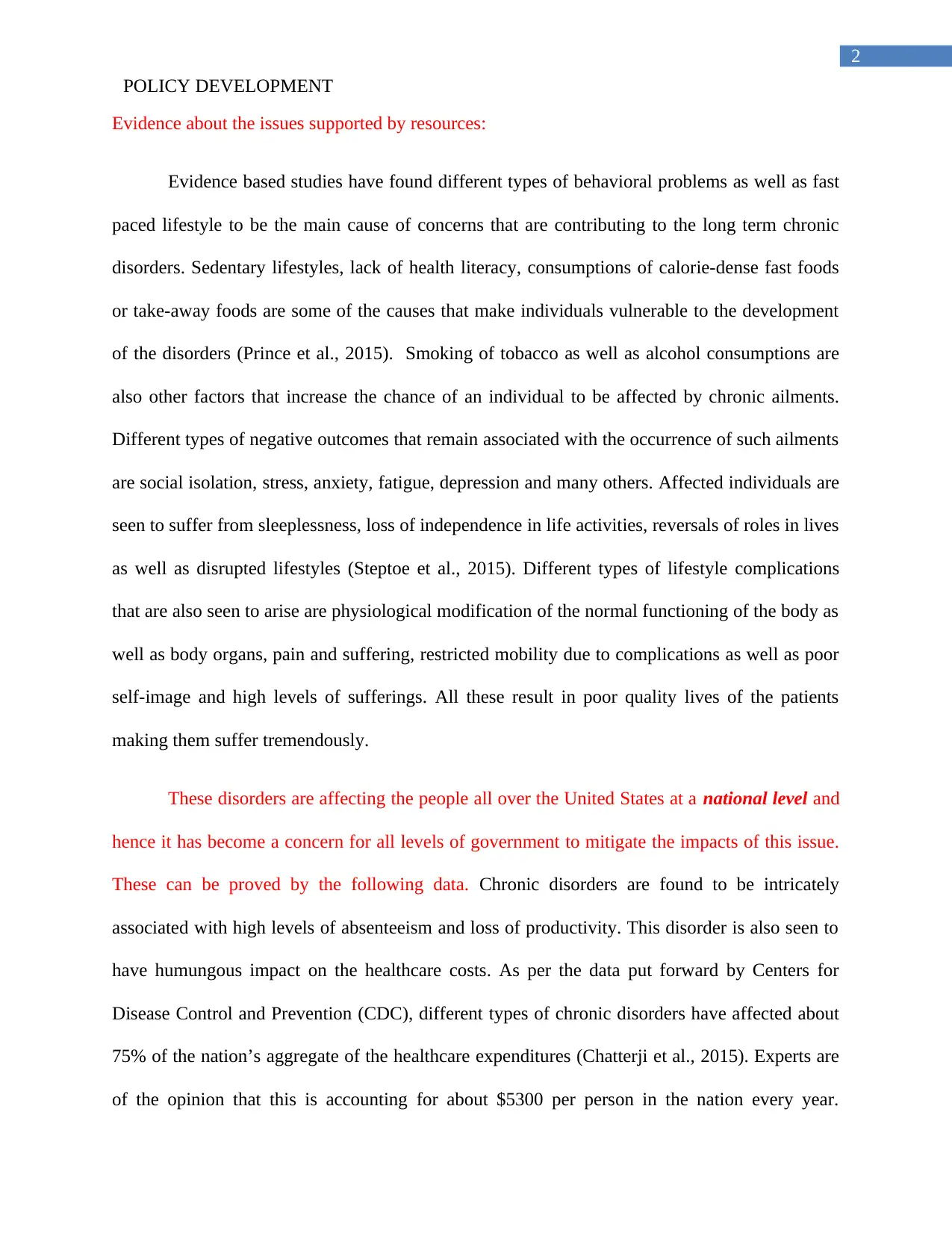
2
POLICY DEVELOPMENT
Evidence about the issues supported by resources:
Evidence based studies have found different types of behavioral problems as well as fast
paced lifestyle to be the main cause of concerns that are contributing to the long term chronic
disorders. Sedentary lifestyles, lack of health literacy, consumptions of calorie-dense fast foods
or take-away foods are some of the causes that make individuals vulnerable to the development
of the disorders (Prince et al., 2015). Smoking of tobacco as well as alcohol consumptions are
also other factors that increase the chance of an individual to be affected by chronic ailments.
Different types of negative outcomes that remain associated with the occurrence of such ailments
are social isolation, stress, anxiety, fatigue, depression and many others. Affected individuals are
seen to suffer from sleeplessness, loss of independence in life activities, reversals of roles in lives
as well as disrupted lifestyles (Steptoe et al., 2015). Different types of lifestyle complications
that are also seen to arise are physiological modification of the normal functioning of the body as
well as body organs, pain and suffering, restricted mobility due to complications as well as poor
self-image and high levels of sufferings. All these result in poor quality lives of the patients
making them suffer tremendously.
These disorders are affecting the people all over the United States at a national level and
hence it has become a concern for all levels of government to mitigate the impacts of this issue.
These can be proved by the following data. Chronic disorders are found to be intricately
associated with high levels of absenteeism and loss of productivity. This disorder is also seen to
have humungous impact on the healthcare costs. As per the data put forward by Centers for
Disease Control and Prevention (CDC), different types of chronic disorders have affected about
75% of the nation’s aggregate of the healthcare expenditures (Chatterji et al., 2015). Experts are
of the opinion that this is accounting for about $5300 per person in the nation every year.
POLICY DEVELOPMENT
Evidence about the issues supported by resources:
Evidence based studies have found different types of behavioral problems as well as fast
paced lifestyle to be the main cause of concerns that are contributing to the long term chronic
disorders. Sedentary lifestyles, lack of health literacy, consumptions of calorie-dense fast foods
or take-away foods are some of the causes that make individuals vulnerable to the development
of the disorders (Prince et al., 2015). Smoking of tobacco as well as alcohol consumptions are
also other factors that increase the chance of an individual to be affected by chronic ailments.
Different types of negative outcomes that remain associated with the occurrence of such ailments
are social isolation, stress, anxiety, fatigue, depression and many others. Affected individuals are
seen to suffer from sleeplessness, loss of independence in life activities, reversals of roles in lives
as well as disrupted lifestyles (Steptoe et al., 2015). Different types of lifestyle complications
that are also seen to arise are physiological modification of the normal functioning of the body as
well as body organs, pain and suffering, restricted mobility due to complications as well as poor
self-image and high levels of sufferings. All these result in poor quality lives of the patients
making them suffer tremendously.
These disorders are affecting the people all over the United States at a national level and
hence it has become a concern for all levels of government to mitigate the impacts of this issue.
These can be proved by the following data. Chronic disorders are found to be intricately
associated with high levels of absenteeism and loss of productivity. This disorder is also seen to
have humungous impact on the healthcare costs. As per the data put forward by Centers for
Disease Control and Prevention (CDC), different types of chronic disorders have affected about
75% of the nation’s aggregate of the healthcare expenditures (Chatterji et al., 2015). Experts are
of the opinion that this is accounting for about $5300 per person in the nation every year.
⊘ This is a preview!⊘
Do you want full access?
Subscribe today to unlock all pages.

Trusted by 1+ million students worldwide
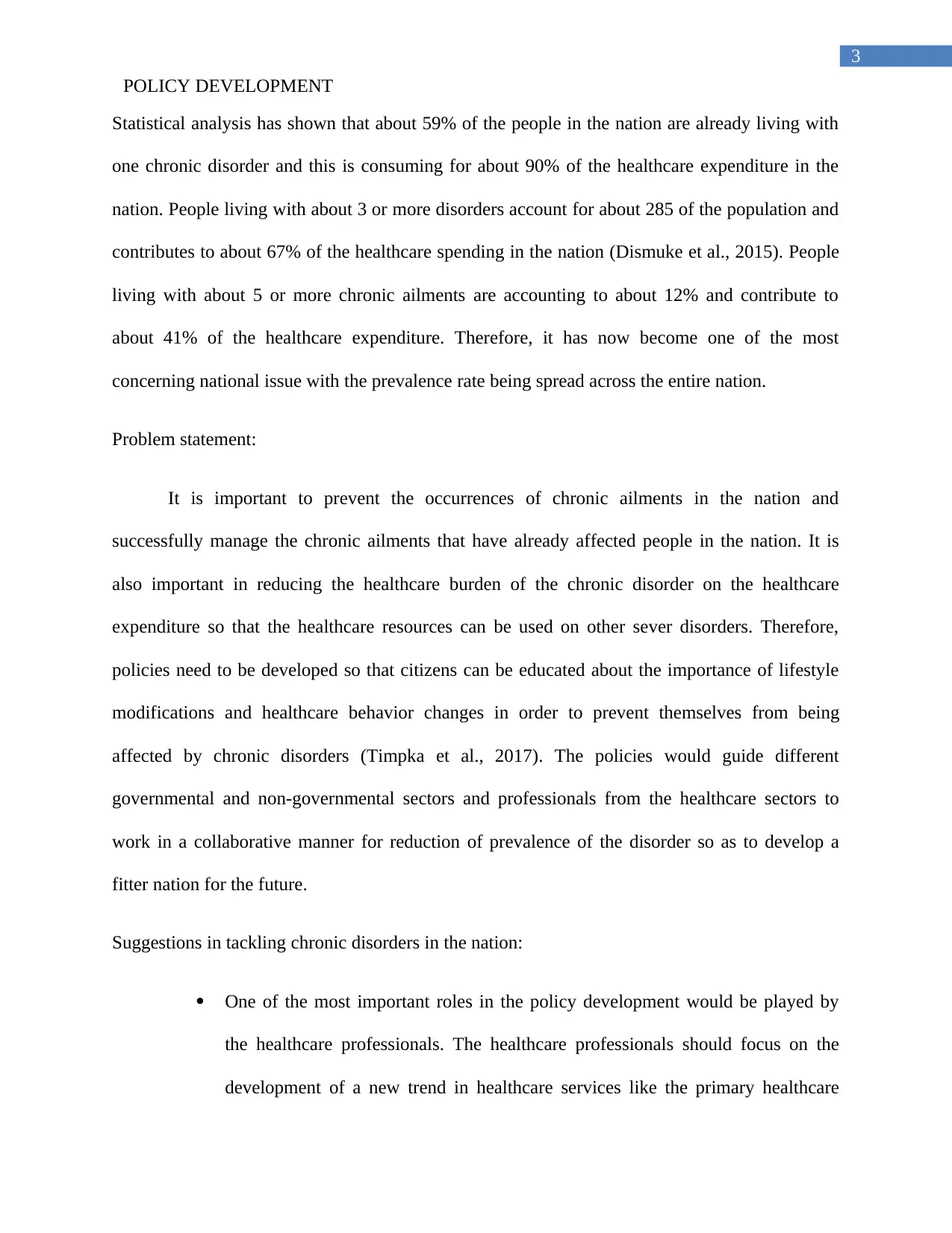
3
POLICY DEVELOPMENT
Statistical analysis has shown that about 59% of the people in the nation are already living with
one chronic disorder and this is consuming for about 90% of the healthcare expenditure in the
nation. People living with about 3 or more disorders account for about 285 of the population and
contributes to about 67% of the healthcare spending in the nation (Dismuke et al., 2015). People
living with about 5 or more chronic ailments are accounting to about 12% and contribute to
about 41% of the healthcare expenditure. Therefore, it has now become one of the most
concerning national issue with the prevalence rate being spread across the entire nation.
Problem statement:
It is important to prevent the occurrences of chronic ailments in the nation and
successfully manage the chronic ailments that have already affected people in the nation. It is
also important in reducing the healthcare burden of the chronic disorder on the healthcare
expenditure so that the healthcare resources can be used on other sever disorders. Therefore,
policies need to be developed so that citizens can be educated about the importance of lifestyle
modifications and healthcare behavior changes in order to prevent themselves from being
affected by chronic disorders (Timpka et al., 2017). The policies would guide different
governmental and non-governmental sectors and professionals from the healthcare sectors to
work in a collaborative manner for reduction of prevalence of the disorder so as to develop a
fitter nation for the future.
Suggestions in tackling chronic disorders in the nation:
One of the most important roles in the policy development would be played by
the healthcare professionals. The healthcare professionals should focus on the
development of a new trend in healthcare services like the primary healthcare
POLICY DEVELOPMENT
Statistical analysis has shown that about 59% of the people in the nation are already living with
one chronic disorder and this is consuming for about 90% of the healthcare expenditure in the
nation. People living with about 3 or more disorders account for about 285 of the population and
contributes to about 67% of the healthcare spending in the nation (Dismuke et al., 2015). People
living with about 5 or more chronic ailments are accounting to about 12% and contribute to
about 41% of the healthcare expenditure. Therefore, it has now become one of the most
concerning national issue with the prevalence rate being spread across the entire nation.
Problem statement:
It is important to prevent the occurrences of chronic ailments in the nation and
successfully manage the chronic ailments that have already affected people in the nation. It is
also important in reducing the healthcare burden of the chronic disorder on the healthcare
expenditure so that the healthcare resources can be used on other sever disorders. Therefore,
policies need to be developed so that citizens can be educated about the importance of lifestyle
modifications and healthcare behavior changes in order to prevent themselves from being
affected by chronic disorders (Timpka et al., 2017). The policies would guide different
governmental and non-governmental sectors and professionals from the healthcare sectors to
work in a collaborative manner for reduction of prevalence of the disorder so as to develop a
fitter nation for the future.
Suggestions in tackling chronic disorders in the nation:
One of the most important roles in the policy development would be played by
the healthcare professionals. The healthcare professionals should focus on the
development of a new trend in healthcare services like the primary healthcare
Paraphrase This Document
Need a fresh take? Get an instant paraphrase of this document with our AI Paraphraser
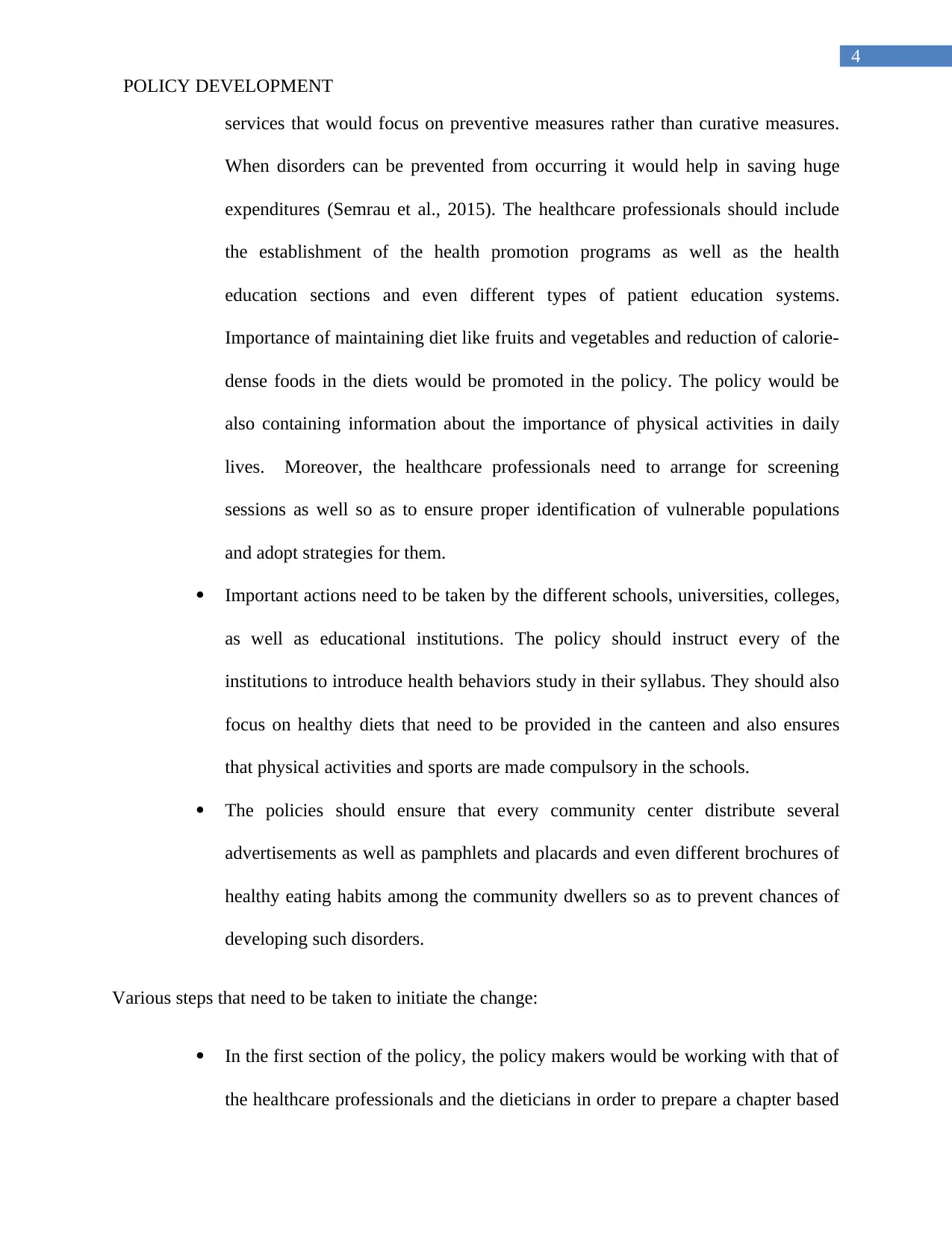
4
POLICY DEVELOPMENT
services that would focus on preventive measures rather than curative measures.
When disorders can be prevented from occurring it would help in saving huge
expenditures (Semrau et al., 2015). The healthcare professionals should include
the establishment of the health promotion programs as well as the health
education sections and even different types of patient education systems.
Importance of maintaining diet like fruits and vegetables and reduction of calorie-
dense foods in the diets would be promoted in the policy. The policy would be
also containing information about the importance of physical activities in daily
lives. Moreover, the healthcare professionals need to arrange for screening
sessions as well so as to ensure proper identification of vulnerable populations
and adopt strategies for them.
Important actions need to be taken by the different schools, universities, colleges,
as well as educational institutions. The policy should instruct every of the
institutions to introduce health behaviors study in their syllabus. They should also
focus on healthy diets that need to be provided in the canteen and also ensures
that physical activities and sports are made compulsory in the schools.
The policies should ensure that every community center distribute several
advertisements as well as pamphlets and placards and even different brochures of
healthy eating habits among the community dwellers so as to prevent chances of
developing such disorders.
Various steps that need to be taken to initiate the change:
In the first section of the policy, the policy makers would be working with that of
the healthcare professionals and the dieticians in order to prepare a chapter based
POLICY DEVELOPMENT
services that would focus on preventive measures rather than curative measures.
When disorders can be prevented from occurring it would help in saving huge
expenditures (Semrau et al., 2015). The healthcare professionals should include
the establishment of the health promotion programs as well as the health
education sections and even different types of patient education systems.
Importance of maintaining diet like fruits and vegetables and reduction of calorie-
dense foods in the diets would be promoted in the policy. The policy would be
also containing information about the importance of physical activities in daily
lives. Moreover, the healthcare professionals need to arrange for screening
sessions as well so as to ensure proper identification of vulnerable populations
and adopt strategies for them.
Important actions need to be taken by the different schools, universities, colleges,
as well as educational institutions. The policy should instruct every of the
institutions to introduce health behaviors study in their syllabus. They should also
focus on healthy diets that need to be provided in the canteen and also ensures
that physical activities and sports are made compulsory in the schools.
The policies should ensure that every community center distribute several
advertisements as well as pamphlets and placards and even different brochures of
healthy eating habits among the community dwellers so as to prevent chances of
developing such disorders.
Various steps that need to be taken to initiate the change:
In the first section of the policy, the policy makers would be working with that of
the healthcare professionals and the dieticians in order to prepare a chapter based
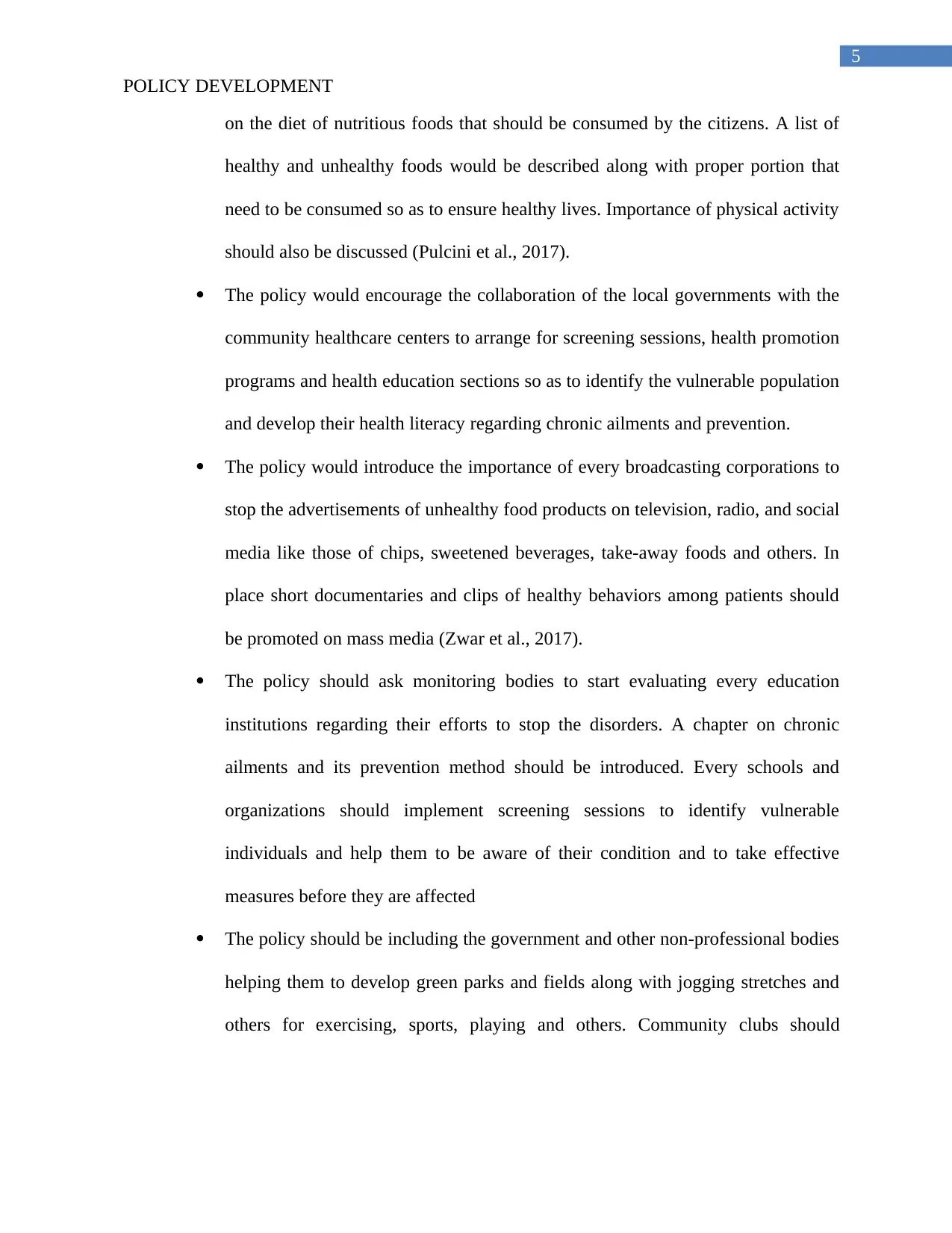
5
POLICY DEVELOPMENT
on the diet of nutritious foods that should be consumed by the citizens. A list of
healthy and unhealthy foods would be described along with proper portion that
need to be consumed so as to ensure healthy lives. Importance of physical activity
should also be discussed (Pulcini et al., 2017).
The policy would encourage the collaboration of the local governments with the
community healthcare centers to arrange for screening sessions, health promotion
programs and health education sections so as to identify the vulnerable population
and develop their health literacy regarding chronic ailments and prevention.
The policy would introduce the importance of every broadcasting corporations to
stop the advertisements of unhealthy food products on television, radio, and social
media like those of chips, sweetened beverages, take-away foods and others. In
place short documentaries and clips of healthy behaviors among patients should
be promoted on mass media (Zwar et al., 2017).
The policy should ask monitoring bodies to start evaluating every education
institutions regarding their efforts to stop the disorders. A chapter on chronic
ailments and its prevention method should be introduced. Every schools and
organizations should implement screening sessions to identify vulnerable
individuals and help them to be aware of their condition and to take effective
measures before they are affected
The policy should be including the government and other non-professional bodies
helping them to develop green parks and fields along with jogging stretches and
others for exercising, sports, playing and others. Community clubs should
POLICY DEVELOPMENT
on the diet of nutritious foods that should be consumed by the citizens. A list of
healthy and unhealthy foods would be described along with proper portion that
need to be consumed so as to ensure healthy lives. Importance of physical activity
should also be discussed (Pulcini et al., 2017).
The policy would encourage the collaboration of the local governments with the
community healthcare centers to arrange for screening sessions, health promotion
programs and health education sections so as to identify the vulnerable population
and develop their health literacy regarding chronic ailments and prevention.
The policy would introduce the importance of every broadcasting corporations to
stop the advertisements of unhealthy food products on television, radio, and social
media like those of chips, sweetened beverages, take-away foods and others. In
place short documentaries and clips of healthy behaviors among patients should
be promoted on mass media (Zwar et al., 2017).
The policy should ask monitoring bodies to start evaluating every education
institutions regarding their efforts to stop the disorders. A chapter on chronic
ailments and its prevention method should be introduced. Every schools and
organizations should implement screening sessions to identify vulnerable
individuals and help them to be aware of their condition and to take effective
measures before they are affected
The policy should be including the government and other non-professional bodies
helping them to develop green parks and fields along with jogging stretches and
others for exercising, sports, playing and others. Community clubs should
⊘ This is a preview!⊘
Do you want full access?
Subscribe today to unlock all pages.

Trusted by 1+ million students worldwide
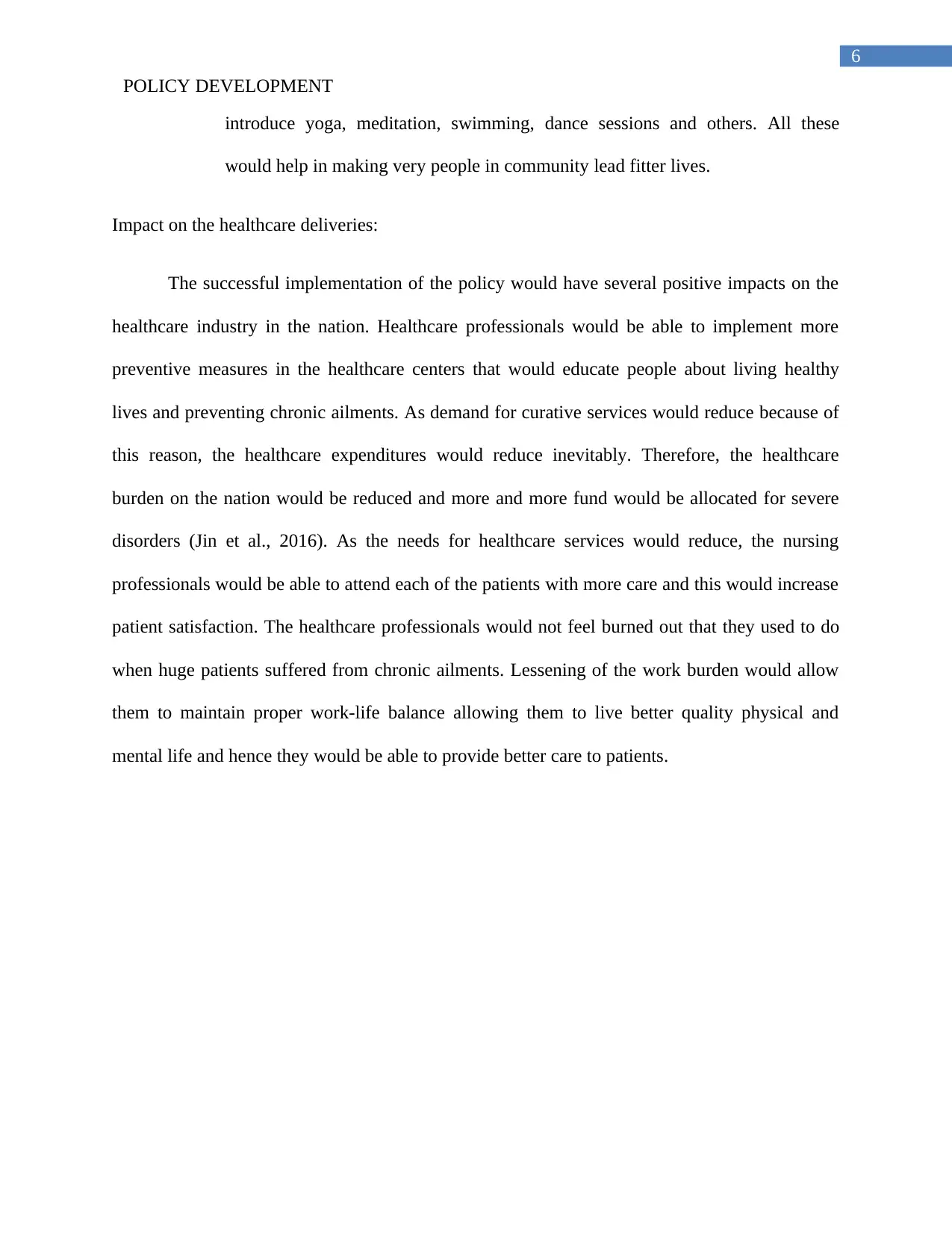
6
POLICY DEVELOPMENT
introduce yoga, meditation, swimming, dance sessions and others. All these
would help in making very people in community lead fitter lives.
Impact on the healthcare deliveries:
The successful implementation of the policy would have several positive impacts on the
healthcare industry in the nation. Healthcare professionals would be able to implement more
preventive measures in the healthcare centers that would educate people about living healthy
lives and preventing chronic ailments. As demand for curative services would reduce because of
this reason, the healthcare expenditures would reduce inevitably. Therefore, the healthcare
burden on the nation would be reduced and more and more fund would be allocated for severe
disorders (Jin et al., 2016). As the needs for healthcare services would reduce, the nursing
professionals would be able to attend each of the patients with more care and this would increase
patient satisfaction. The healthcare professionals would not feel burned out that they used to do
when huge patients suffered from chronic ailments. Lessening of the work burden would allow
them to maintain proper work-life balance allowing them to live better quality physical and
mental life and hence they would be able to provide better care to patients.
POLICY DEVELOPMENT
introduce yoga, meditation, swimming, dance sessions and others. All these
would help in making very people in community lead fitter lives.
Impact on the healthcare deliveries:
The successful implementation of the policy would have several positive impacts on the
healthcare industry in the nation. Healthcare professionals would be able to implement more
preventive measures in the healthcare centers that would educate people about living healthy
lives and preventing chronic ailments. As demand for curative services would reduce because of
this reason, the healthcare expenditures would reduce inevitably. Therefore, the healthcare
burden on the nation would be reduced and more and more fund would be allocated for severe
disorders (Jin et al., 2016). As the needs for healthcare services would reduce, the nursing
professionals would be able to attend each of the patients with more care and this would increase
patient satisfaction. The healthcare professionals would not feel burned out that they used to do
when huge patients suffered from chronic ailments. Lessening of the work burden would allow
them to maintain proper work-life balance allowing them to live better quality physical and
mental life and hence they would be able to provide better care to patients.
Paraphrase This Document
Need a fresh take? Get an instant paraphrase of this document with our AI Paraphraser
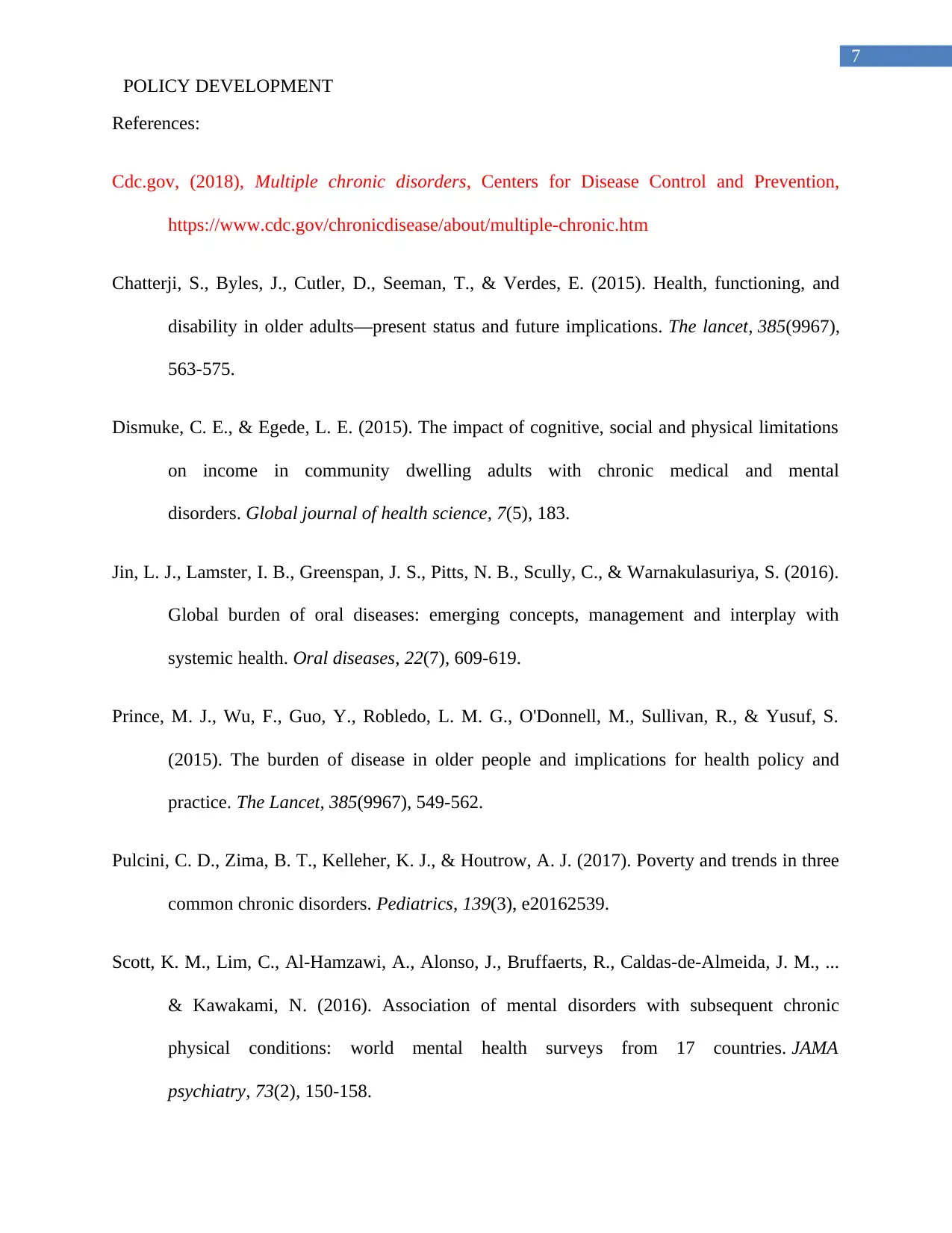
7
POLICY DEVELOPMENT
References:
Cdc.gov, (2018), Multiple chronic disorders, Centers for Disease Control and Prevention,
https://www.cdc.gov/chronicdisease/about/multiple-chronic.htm
Chatterji, S., Byles, J., Cutler, D., Seeman, T., & Verdes, E. (2015). Health, functioning, and
disability in older adults—present status and future implications. The lancet, 385(9967),
563-575.
Dismuke, C. E., & Egede, L. E. (2015). The impact of cognitive, social and physical limitations
on income in community dwelling adults with chronic medical and mental
disorders. Global journal of health science, 7(5), 183.
Jin, L. J., Lamster, I. B., Greenspan, J. S., Pitts, N. B., Scully, C., & Warnakulasuriya, S. (2016).
Global burden of oral diseases: emerging concepts, management and interplay with
systemic health. Oral diseases, 22(7), 609-619.
Prince, M. J., Wu, F., Guo, Y., Robledo, L. M. G., O'Donnell, M., Sullivan, R., & Yusuf, S.
(2015). The burden of disease in older people and implications for health policy and
practice. The Lancet, 385(9967), 549-562.
Pulcini, C. D., Zima, B. T., Kelleher, K. J., & Houtrow, A. J. (2017). Poverty and trends in three
common chronic disorders. Pediatrics, 139(3), e20162539.
Scott, K. M., Lim, C., Al-Hamzawi, A., Alonso, J., Bruffaerts, R., Caldas-de-Almeida, J. M., ...
& Kawakami, N. (2016). Association of mental disorders with subsequent chronic
physical conditions: world mental health surveys from 17 countries. JAMA
psychiatry, 73(2), 150-158.
POLICY DEVELOPMENT
References:
Cdc.gov, (2018), Multiple chronic disorders, Centers for Disease Control and Prevention,
https://www.cdc.gov/chronicdisease/about/multiple-chronic.htm
Chatterji, S., Byles, J., Cutler, D., Seeman, T., & Verdes, E. (2015). Health, functioning, and
disability in older adults—present status and future implications. The lancet, 385(9967),
563-575.
Dismuke, C. E., & Egede, L. E. (2015). The impact of cognitive, social and physical limitations
on income in community dwelling adults with chronic medical and mental
disorders. Global journal of health science, 7(5), 183.
Jin, L. J., Lamster, I. B., Greenspan, J. S., Pitts, N. B., Scully, C., & Warnakulasuriya, S. (2016).
Global burden of oral diseases: emerging concepts, management and interplay with
systemic health. Oral diseases, 22(7), 609-619.
Prince, M. J., Wu, F., Guo, Y., Robledo, L. M. G., O'Donnell, M., Sullivan, R., & Yusuf, S.
(2015). The burden of disease in older people and implications for health policy and
practice. The Lancet, 385(9967), 549-562.
Pulcini, C. D., Zima, B. T., Kelleher, K. J., & Houtrow, A. J. (2017). Poverty and trends in three
common chronic disorders. Pediatrics, 139(3), e20162539.
Scott, K. M., Lim, C., Al-Hamzawi, A., Alonso, J., Bruffaerts, R., Caldas-de-Almeida, J. M., ...
& Kawakami, N. (2016). Association of mental disorders with subsequent chronic
physical conditions: world mental health surveys from 17 countries. JAMA
psychiatry, 73(2), 150-158.
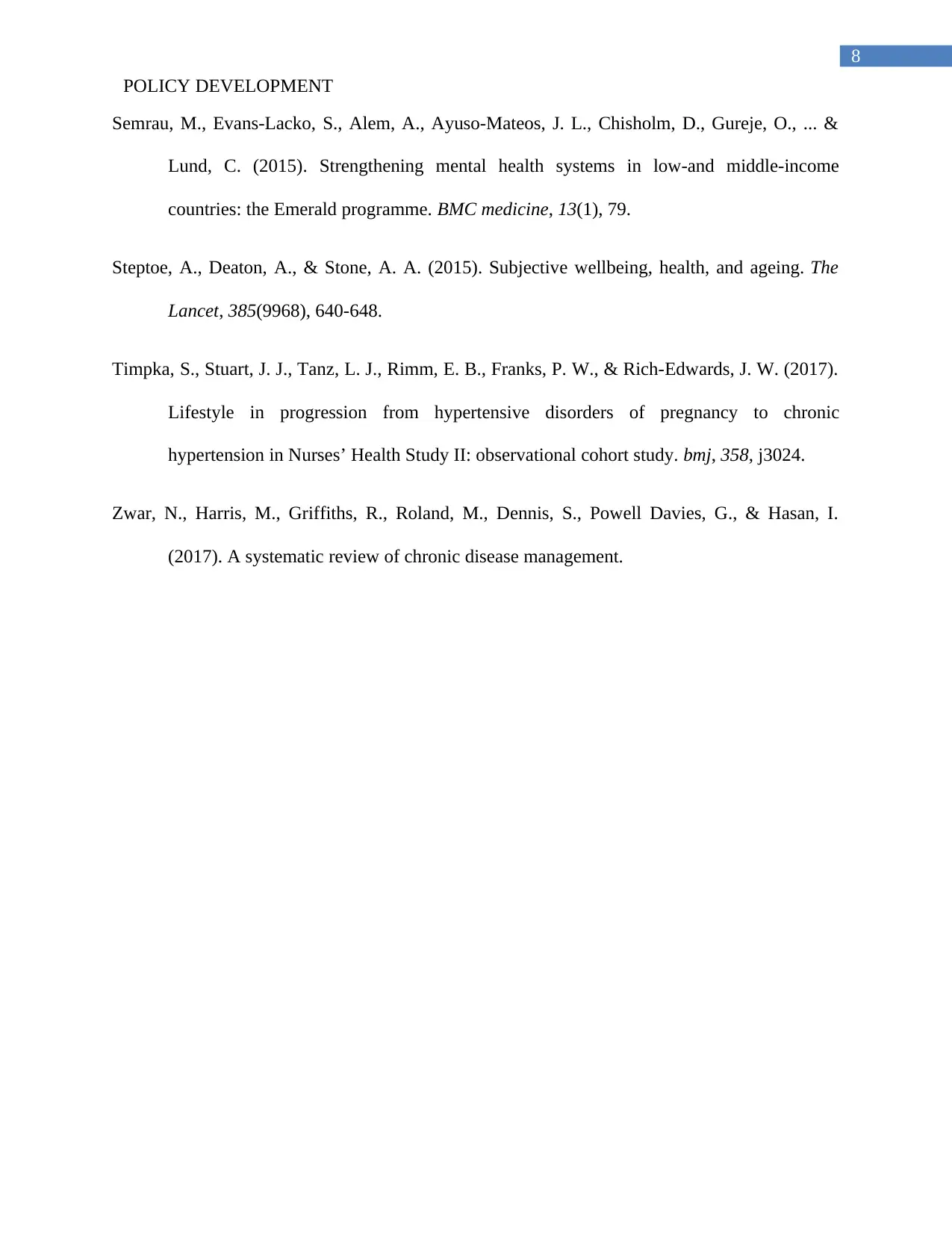
8
POLICY DEVELOPMENT
Semrau, M., Evans-Lacko, S., Alem, A., Ayuso-Mateos, J. L., Chisholm, D., Gureje, O., ... &
Lund, C. (2015). Strengthening mental health systems in low-and middle-income
countries: the Emerald programme. BMC medicine, 13(1), 79.
Steptoe, A., Deaton, A., & Stone, A. A. (2015). Subjective wellbeing, health, and ageing. The
Lancet, 385(9968), 640-648.
Timpka, S., Stuart, J. J., Tanz, L. J., Rimm, E. B., Franks, P. W., & Rich-Edwards, J. W. (2017).
Lifestyle in progression from hypertensive disorders of pregnancy to chronic
hypertension in Nurses’ Health Study II: observational cohort study. bmj, 358, j3024.
Zwar, N., Harris, M., Griffiths, R., Roland, M., Dennis, S., Powell Davies, G., & Hasan, I.
(2017). A systematic review of chronic disease management.
POLICY DEVELOPMENT
Semrau, M., Evans-Lacko, S., Alem, A., Ayuso-Mateos, J. L., Chisholm, D., Gureje, O., ... &
Lund, C. (2015). Strengthening mental health systems in low-and middle-income
countries: the Emerald programme. BMC medicine, 13(1), 79.
Steptoe, A., Deaton, A., & Stone, A. A. (2015). Subjective wellbeing, health, and ageing. The
Lancet, 385(9968), 640-648.
Timpka, S., Stuart, J. J., Tanz, L. J., Rimm, E. B., Franks, P. W., & Rich-Edwards, J. W. (2017).
Lifestyle in progression from hypertensive disorders of pregnancy to chronic
hypertension in Nurses’ Health Study II: observational cohort study. bmj, 358, j3024.
Zwar, N., Harris, M., Griffiths, R., Roland, M., Dennis, S., Powell Davies, G., & Hasan, I.
(2017). A systematic review of chronic disease management.
⊘ This is a preview!⊘
Do you want full access?
Subscribe today to unlock all pages.

Trusted by 1+ million students worldwide
1 out of 9
Related Documents
Your All-in-One AI-Powered Toolkit for Academic Success.
+13062052269
info@desklib.com
Available 24*7 on WhatsApp / Email
![[object Object]](/_next/static/media/star-bottom.7253800d.svg)
Unlock your academic potential
Copyright © 2020–2025 A2Z Services. All Rights Reserved. Developed and managed by ZUCOL.





